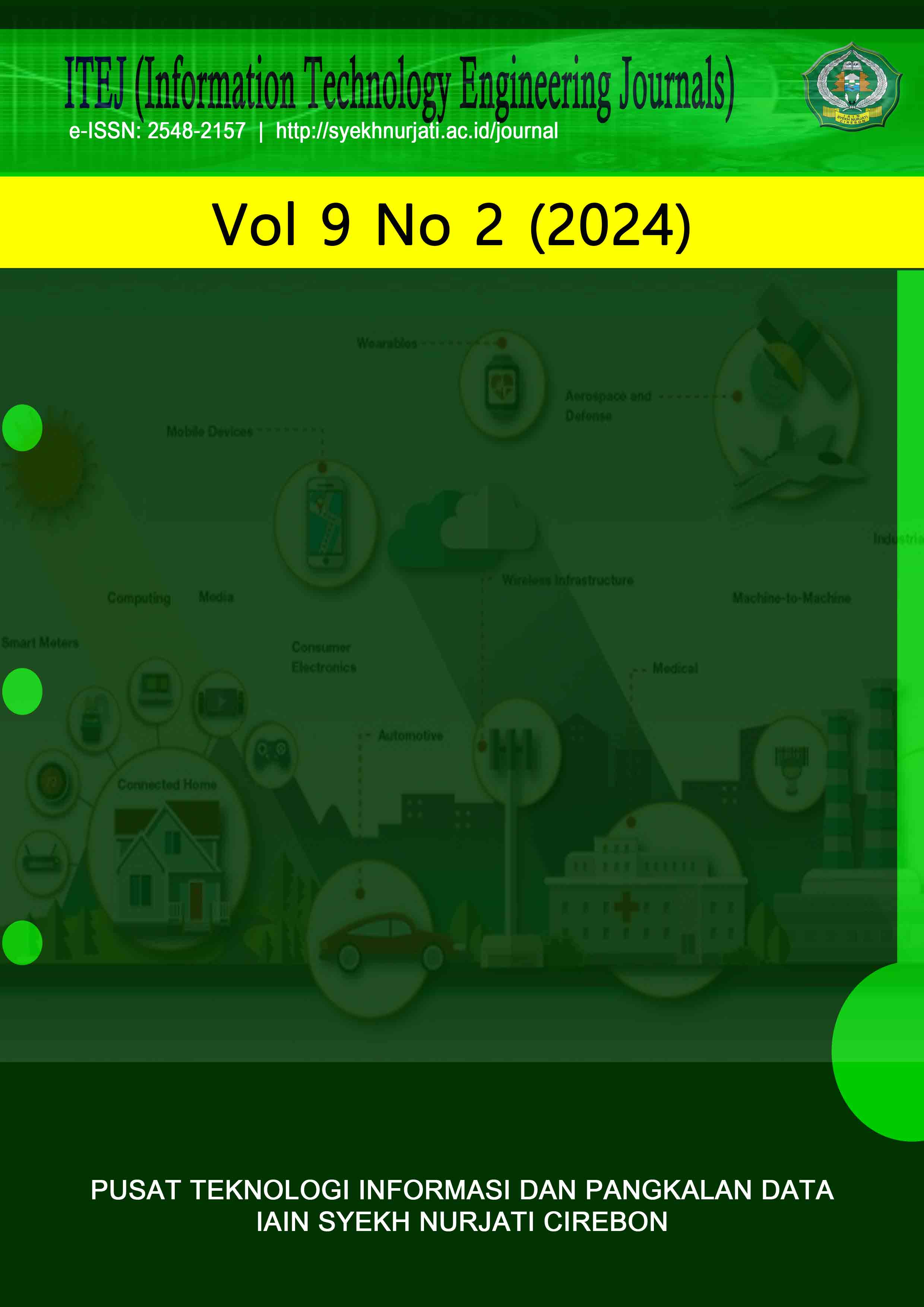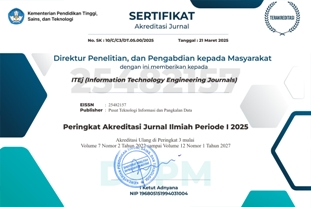Design and Implementation of Network Security Systems on Virtualized Networks
Abstract
This report, entitled "Design and Implementation of Network Security Systems on Virtualized Networks," was prepared to fulfill the final assignment of the Network Security course at the Bacharuddin Jusuf Habibie Institute of Technology (ITH). This research aims to design, implement and identify network security vulnerabilities in a virtualization environment using Proxmox Virtual Environment (Proxmox VE) in VirtualBox. The research results show that Proxmox VE in VirtualBox is less successful in optimizing software-hardware resources by implementing security mechanisms such as firewalls, encryption, IDS/IPS, VPN, and IAM. Even though it has several shortcomings, Proxmox VE has proven to be effective in managing virtual networks safely and efficiently when carried out outside of VirtualBox. This research also provides practical experience for students in implementing and identifying network security vulnerabilities, preparing them for real-world challenges.
Downloads
References
H. Li, “Simulation of education digital network security and anomaly detection based on neural networks,” Comput. Electr. Eng., vol. 112, p. 108992, Dec. 2023, doi: https://doi.org/10.1016/j.compeleceng.2023.108992.
M. Wang, “Optimization of Network Security in University Laboratories Based on Anomaly Intrusion Detection in Public Cloud Networks,” Comput. Electr. Eng., vol. 111, p. 108968, Nov. 2023, doi: https://doi.org/10.1016/j.compeleceng.2023.108968.
J. Braun and F. Derbel, “Wireless sensor network for fire detection with network coding to improve security and reliability,” Meas. Sensors, p. 101404, Dec. 2024, doi: https://doi.org/10.1016/j.measen.2024.101404.
A. Ali et al., “An optimized multilayer perceptron-based network intrusion detection using Gray Wolf Optimization,” Comput. Electr. Eng., vol. 120, p. 109838, Dec. 2024, doi: https://doi.org/10.1016/j.compeleceng.2024.109838.
M. Rajkumar, J. Karthika, and S. S. Abinayaa, “Multi-View Consistent Generative Adversarial Network for Enhancing Intrusion Detection with Prevention Systems in Mobile Ad Hoc Networks Against Security Attacks,” Comput. Secur., p. 104242, Nov. 2024, doi: https://doi.org/10.1016/j.cose.2024.104242.
F. Dong et al., “Floor failure behavior and water disaster prevention system of ultra-wide opposite pulling working face mining on confined aquifer,” Eng. Fail. Anal., vol. 165, p. 108736, Nov. 2024, doi: https://doi.org/10.1016/j.engfailanal.2024.108736.
M. J. Pasha, K. P. Rao, A. MallaReddy, and V. Bande, “LRDADF: An AI enabled framework for detecting low-rate DDoS attacks in cloud computing environments,” Meas. Sensors, vol. 28, p. 100828, Aug. 2023, doi: https://doi.org/10.1016/j.measen.2023.100828.
S. A. A. Mohamed and S. Kurnaz, “Classified VPN Network Traffic Flow Using Time Related to Artificial Neural Network,” Comput. Mater. Contin., vol. 80, no. 1, pp. 819–841, 2024, doi: https://doi.org/10.32604/cmc.2024.050474.
X. He and Q. Zhang, “Cloud Computing Based Digital Media Content Distribution Technology,” Procedia Comput. Sci., vol. 247, pp. 461–468, 2024, doi: https://doi.org/10.1016/j.procs.2024.10.055.
J. Lu and X. S. Zhou, “Virtual track networks: A hierarchical modeling framework and open-source tools for simplified and efficient connected and automated mobility (CAM) system design based on general modeling network specification (GMNS),” Transp. Res. Part C Emerg. Technol., vol. 153, p. 104223, Aug. 2023, doi: https://doi.org/10.1016/j.trc.2023.104223.
Y. Mansouri and M. A. Babar, “A review of edge computing: Features and resource virtualization,” J. Parallel Distrib. Comput., vol. 150, pp. 155–183, Apr. 2021, doi: https://doi.org/10.1016/j.jpdc.2020.12.015.
E. Ali, Susandri, and Rahmaddeni, “Optimizing Server Resource by Using Virtualization Technology,” Procedia Comput. Sci., vol. 59, pp. 320–325, 2015, doi: https://doi.org/10.1016/j.procs.2015.07.572.
A. Aldribi, I. Traoré, B. Moa, and O. Nwamuo, “Hypervisor-based cloud intrusion detection through online multivariate statistical change tracking,” Comput. Secur., vol. 88, p. 101646, Jan. 2020, doi: https://doi.org/10.1016/j.cose.2019.101646.
R. Zhang and Z. Hu, “Access control method of network security authentication information based on fuzzy reasoning algorithm,” Measurement, vol. 185, p. 110103, Nov. 2021, doi: https://doi.org/10.1016/j.measurement.2021.110103.
Q. Liu and T. Zhang, “Deep learning technology of computer network security detection based on artificial intelligence,” Comput. Electr. Eng., vol. 110, p. 108813, Sep. 2023, doi: https://doi.org/10.1016/j.compeleceng.2023.108813.
E. Andrade, J. Granjal, J. P. Vilela, and C. Arantes, “A Security Gateway for power distribution systems in open networks,” Comput. Secur., vol. 111, p. 102492, Dec. 2021, doi: https://doi.org/10.1016/j.cose.2021.102492.
A. A and L. NG, “Analysis and Detection of Weeds Using Artificial Neural Networks,” ITEJ (Information Technol. Eng. Journals), vol. 7, no. 2, pp. 123–131, Dec. 2022, doi: https://doi.org/10.24235/itej.v7i2.107.
E. Chisari, J. Cho, M. Wouthuyzen-Bakker, and J. Parvizi, “Periprosthetic Joint Infection and the Trojan Horse Theory: Examining the Role of Gut Dysbiosis and Epithelial Integrity,” J. Arthroplasty, vol. 37, no. 7, pp. 1369–1374, Jul. 2022, doi: https://doi.org/10.1016/j.arth.2022.03.030.
F. N. Laukotka and D. Krause, “Virtual Representations of Physical Assets – a literature study about Digital Twins from the perspective of application in aviation’s retrofit,” Procedia CIRP, vol. 119, pp. 926–931, 2023, doi: https://doi.org/10.1016/j.procir.2023.03.136.
M. Revilla-León, A. Zandinejad, M. K. Nair, A. B. Barmak, A. J. Feilzer, and M. Özcan, “Accuracy of a patient 3-dimensional virtual representation obtained from the superimposition of facial and intraoral scans guided by extraoral and intraoral scan body systems,” J. Prosthet. Dent., vol. 128, no. 5, pp. 984–993, Nov. 2022, doi: https://doi.org/10.1016/j.prosdent.2021.02.023.
B. Dordevic, V. Timcenko, N. Kraljevic, and N. Jovicic, “Performance comparison of KVM and Proxmox Type-1 Hypervisors,” in 2022 30th Telecommunications Forum (TELFOR), IEEE, Nov. 2022, pp. 1–4. doi: https://doi.org/10.1109/TELFOR56187.2022.9983666.
V. Oleksiuk and O. Oleksiuk, “The practice of developing the academic cloud using the Proxmox VE platform,” Educ. Technol. Q., vol. 2021, no. 4, pp. 605–616, Dec. 2021, doi: https://doi.org/10.55056/etq.36.
A. Anees, M. Field, and L. Holloway, “A neural network-based vertical federated learning framework with server integration,” Eng. Appl. Artif. Intell., vol. 138, p. 109276, Dec. 2024, doi: https://doi.org/10.1016/j.engappai.2024.109276.
A. Sharma and N. Marchang, “A review on client-server attacks and defenses in federated learning,” Comput. Secur., vol. 140, p. 103801, May 2024, doi: https://doi.org/10.1016/j.cose.2024.103801.









